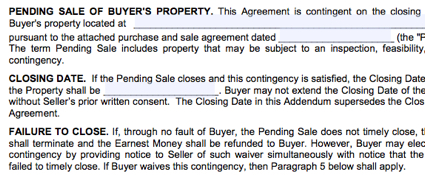A double contingency exists when a buyer makes an offer on a home (“Home A”) contingent upon the sale of the buyer’s own home (“Home B”), and when another buyer makes an offer on Home B contingent on the sale of their home (“Home C”).
Double Contingency Offer
Would a seller be willing to sign an offer with a double contingency? That depends on the strength of the other two offers. In a recent transaction I handled with a double contingency, Home B had already passed all the due diligence inspections and an appraisal came in satisfactorily. The offer on Home C was also a clean offer with the main contingency being approval of the buyer’s loan, and we had a pre-approval letter on that buyer. So this double contingency still made a strong offer for the seller of Home A.
Double Contingency (Multiple Sales)
Almost every offer on a home has at least one contingency, such as financing, the home inspection, the well inspection, and the septic inspection. An additional contingency, such as the sale of the buyer’s home, complicates a transaction. A double contingency increases the probability of failure when you have two transactions that must successfully close in order for the final home (Home A) to close.
A double contingency must be done precisely, and all three transactions have to line up like dominoes to close one after the other. And the Realtors need exemplary knowledge of the correct addendums, the correct contract language, and how to facilitate every step involved. It’s no small challenge, but a double contingency can be done.
Last Updated on September 7, 2019 by Chuck Marunde




























